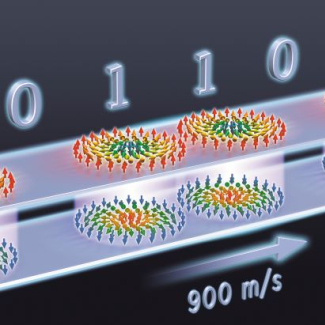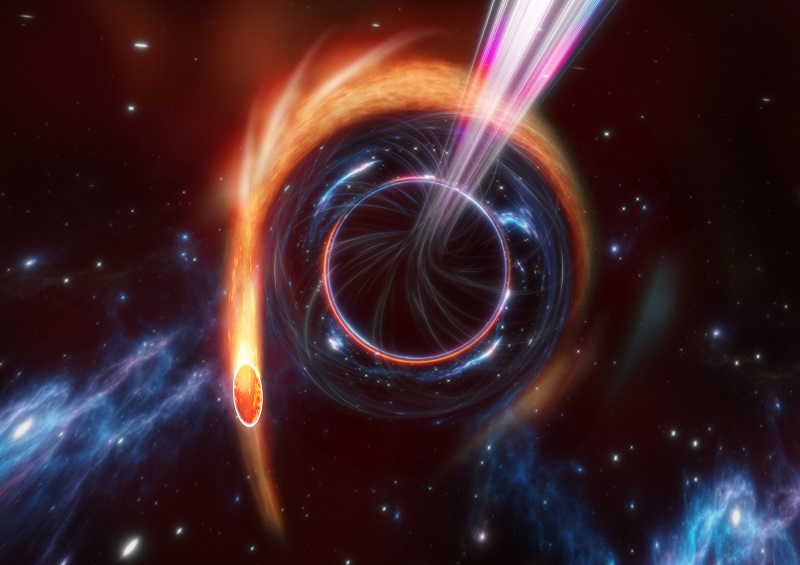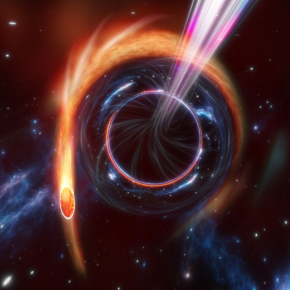
Exceptionally luminous jets: when a star meets a black hole
For the first time in over a decade, scientists from the CNRS and the Institut de radioastronomie millimétrique1 , together with international colleagues, have observed a tidal disruption event (TDE) with jets, a very rare occurrence resulting from an encounter between a star and a supermassive black hole (SMBH). When such an event occurs, gravity disrupts the star: its matter breaks apart and spins quickly before being submerged by the black hole. Occasionally, the latter emits jets of matter travelling at slightly less than the speed of light. Such a rare emission, observed by the research teams and named AT2022cmc, is the subject of an article published on 30 November in the journal Nature. Researchers used methods developed since the last time a TDE was observed in 2012, including the Zwicky Transient Facility: a powerful camera coupled with special software that allows scientists to detect and signal unusual events in real time. Rapid coordination between the research teams, each of which is specialised in a specific form of observation, was key to viewing AT2022cmc. The NOEMA radio telescope2 , for example, helped characterise the source of the event, and a spectrograph installed on the ESO Very Large Telescope was used to assess the origin of this rare phenomenon, estimated to be 8.5 billion light-years from Earth at the centre of its host galaxy. Once the light intensity of this jet of matter diminishes, the galaxy where this event took place can be verified using the Hubble or James Webb space telescopes. For now, scientists do not know why certain encounters between stars and black holes result in the emission of these jets while others do not. One hypothesis is that the black holes associated with these types of events spin extremely fast, which is thought to supply jets as bright as the one produced by AT2022cmc. Scientists hope that the Large Synoptic Survey Telescope (LSST), due to launch in 2024 and to which France has been a major contributor, will help lift the veil on these rare and still unexplained events.

© Carl Knox – OzGrav, ARC Centre of Excellence for Gravitational Wave Discovery, Swinburne University of Technology
- 1In France, this research involved teams from the Artemis laboratory (CNRS/Observatoire de la Côte d’Azur/Université Côte d’Azur), the Institut de radioastronomie millimétrique (IRAM; CNRS/MPG/IGN), the Institute of Nuclear Physics of Lyon (CNRS/Université Claude Bernard Lyon 1), the Institut d’astrophysique de Paris (CNRS/Sorbonne Université) and the Galaxies, Stars, Physics and Instrumentation department of the Paris Observatory (PSL/CNRS).
- 2Northern Extended Millimeter Array. Operated by IRAM, NOEMA is the result of joint efforts by the CNRS, the Max Planck Society for the Advancement of Science (MPG) in Germany and the National Centre for Geographic Information (CNIG) in Spain.
A very luminous jet from the disruption of a star by a massive black hole, Igor Andreoni, Michael W. Coughlin, Daniel A. Perley, Yuhan Yao, Wenbin Lu, S. Bradley Cenko, Harsh Kumar, Shreya Anand, Anna Y. Q. Ho, Mansi M. Kasliwal, Antonio de Ugarte Postigo, Ana Sague´s-Carracedo, Steve Schulze, D. Alexander Kann, S. R. Kulkarni, Jesper Sollerman, Nial Tanvir, Armin Rest, Luca Izzo, Jean J. Somalwar, David L. Kaplan, Toma´s Ahumada, G. C. Anupama, Katie Auchettl, Sudhanshu Barway, Eric C. Bellm, Varun Bhalerao, Joshua S. Bloom, Michael Bremer, Mattia Bulla, Eric Burns, Sergio Campana, Poonam Chandra, Panos Charalampopoulos, Jeff Cooke, Valerio D’Elia, Kaustav Kashyap Das, Dougal Dobie, Jose´ Feliciano Agu¨´ı Ferna´ndez, James Freeburn, Cristoffer Fremling, Suvi Gezari, Simon Goode, Matthew Graham, Erica Hammerstein, Viraj R. Karambelkar, Erik C. Kool, Melanie Krips, Russ R. Laher, Giorgos Leloudas, Andrew Levan, Michael J. Lundquist, Ashish A. Mahabal, Michael S. Medford, M. Coleman Miller, Anais Mo¨ller, Kunal Mooley, A. J. Nayana, Guy Nir, Peter T. H. Pang, Emmy Paraskeva, Richard A. Perley, Glen Petitpas, Miika Pursiainen, Vikram Ravi, Ryan Ridden-Harper, Reed Riddle, Mickael Rigault, Antonio C. Rodriguez, Ben Rusholme, Yashvi Sharma, I. A. Smith, Robert D. Stein, Christina Tho¨ne, Aaron Tohuvavohu, Frank Valdes, Jan van Roestel, Susanna D. Vergani, Qinan Wang and Jielai Zhang. Nature, November 30th 2022. DOI: 10.1038/s41586-022-05465-8

